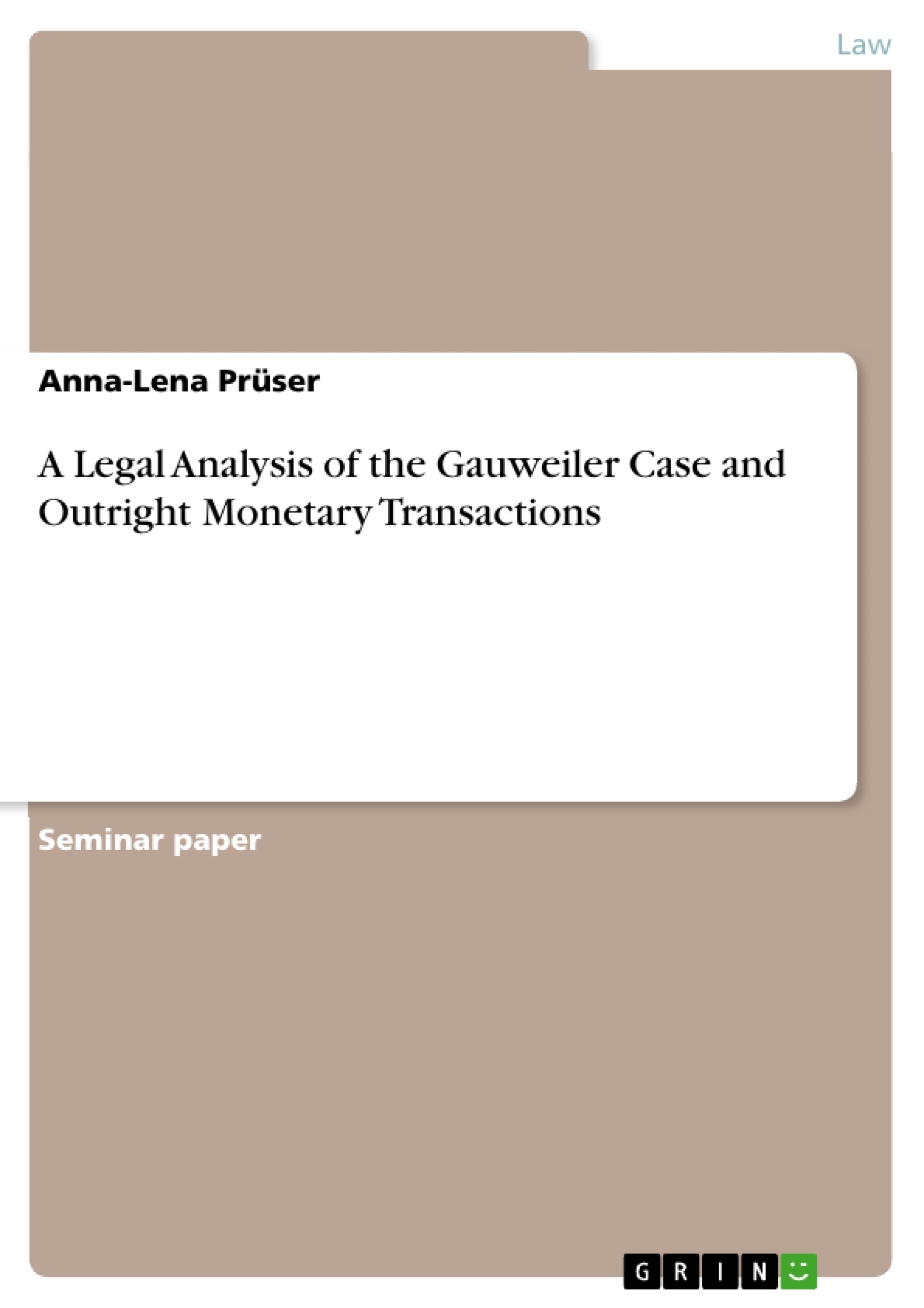On the 26th July 2012, a time characterised by uncertainties about the future of the Eurozone, Mario Draghi, President of the European Central Bank (ECB) declared “Within our mandate, the ECB is ready to do whatever it takes to preserve the euro. And believe me, it will be enough.” The announcement detached historic political, economic and especially legal incidents. Only two months later, the ECB published a press release, which proclaimed the introduction of Outright Monetary Transactions. These operations allowed for the purchase of government bonds form Member States (MSs), which take part in the ESFS or ESM and conquer macroeconomic structural adjustment programmes. Despite the fact that the press release was hardly ever followed by a binding legal act or instrument to implement OMT, the mere pronouncement had the power to reassure the financial markets. From that date on, there were no more such extreme spreads in interest rates for government bonds.
But the announcement caused a judicial tremor, known as the Gauweiler case. In response to Gauweiler and others’ complaint against the OMT, the German Federal Constitutional Court (BVerfG) asked the Europan Court of Justice (ECJ) the first time in history for a preliminary ruling (Art. 267 TFEU) on the legality of the OMT programme. According to the BVerfG the ECB has exceeded its role provided by the Treaties of the European Union ultra vires by initiating a measure that a) has an economic and not a monetary nature (Art. 127 TFEU) and b) violates the prohibition of monetary financing (Art. 123 TFEU). The ECJ’s judgement was very different from that of the BVerfG, in the way that the OMT programme is compatible with EU law in the light of the European Court. Gauweiler had extensive implications on the powers of the ECB, the relation-ship between the ECJ and national courts (especially the BVerfG) and the constitutional framework of the European Economic and Monetary Union (EMU). In addition, the case made important contributions to the distinctions between economic and monetary policy.
Inhaltsverzeichnis (Table of Contents)
- I. Introduction
- II. Demarcation of Courts' Competences
- III. Competences of the ECB, its Role in the Financial Crisis and the OMT Programme
- IV. Decision of the ECJ in Contrast to the Decision of the BVerfG
- a. Admissibility
- i. Perspective of the BVerfG
- ii. Perspective of the ECJ
- b. Economic and Monetary Policy under Art. 127 TFEU
- i. Perspective of the BVerfG
- ii. Perspective of the ECJ
- c. Prohibition of Monetary Financing under Art. 123 TFEU
- i. Perspective of the BVerfG
- ii. Perspective of the ECJ
- d. Reaction of the BVerfG
- a. Admissibility
- V. Consequences of the Ruling
- a. Role of the ECB
- b. The Relationship between the ECJ and the BVerfG
- VI. Summary and Outlook
Zielsetzung und Themenschwerpunkte (Objectives and Key Themes)
This paper aims to provide a legal analysis of the Gauweiler case, focusing on the Outright Monetary Transactions (OMT) program and its implications for the relationship between the European Court of Justice (ECJ) and the German Federal Constitutional Court (BVerfG). It delves into the powers of the European Central Bank (ECB) and its role in the Eurozone sovereign debt crisis, analyzing the legal framework surrounding OMT and the subsequent judicial decisions of the ECJ and BVerfG.
- The legal framework and implications of the OMT program.
- The powers of the ECB and its role during the financial crisis.
- The relationship between the ECJ and the BVerfG in light of the Gauweiler case.
- The distinction between economic and monetary policy in the context of the EU.
- The impact of the Gauweiler case on the constitutional framework of the European Economic and Monetary Union (EMU).
Zusammenfassung der Kapitel (Chapter Summaries)
The introduction presents the background of the Gauweiler case, highlighting the announcement of the OMT program by ECB President Mario Draghi and its impact on financial markets. It also outlines the legal challenge brought before the BVerfG and the ECJ's subsequent ruling.
Chapter II examines the demarcation of competences between the ECJ and the BVerfG, highlighting the differing roles of the courts within the EU system and the BVerfG's assertion of a right to review EU acts in cases of "manifest violation" and "structural shift" in power.
Chapter III delves into the powers and objectives of the ECB, discussing its role in the financial crisis and the introduction of "non-standard" policy instruments, including OMT. This chapter provides context for understanding the legal and economic issues at stake in the Gauweiler case.
Chapter IV presents a comparative analysis of the ECJ's and the BVerfG's decisions on the OMT program, examining the differing perspectives on admissibility, the relationship between economic and monetary policy, and the prohibition of monetary financing.
Chapter V explores the consequences of the Gauweiler ruling, analyzing its implications for the role of the ECB and the relationship between the ECJ and the BVerfG. It also considers the potential impact on the constitutional framework of the EMU.
Schlüsselwörter (Keywords)
The key topics covered in this paper are: Gauweiler case, Outright Monetary Transactions (OMT), European Central Bank (ECB), European Court of Justice (ECJ), German Federal Constitutional Court (BVerfG), Eurozone sovereign debt crisis, economic and monetary policy, constitutional framework of the European Economic and Monetary Union (EMU), judicial review, ultra vires acts, preliminary ruling, Art. 123 TFEU, Art. 127 TFEU, Art. 267 TFEU.
- Citar trabajo
- Anna-Lena Prüser (Autor), 2017, A Legal Analysis of the Gauweiler Case and Outright Monetary Transactions, Múnich, GRIN Verlag, https://www.grin.com/document/445275



